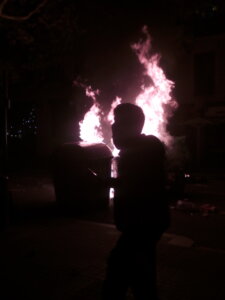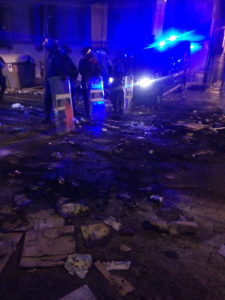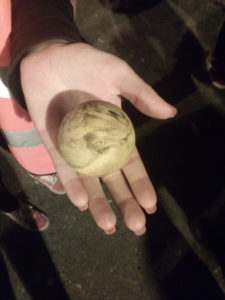Barcelona is on fire!! Protests in Catalunya in October 2019. Since few days there are big protests in Barcelona and in cities around. What’s happening there? Let me explain You.
On October 17, 2018, the supreme court of the Spanish state condemned long pressures to politicians, leaders of Catalan social movements and the president of the Catalan parliament who had proclaimed the independence of Catalonia, as a result of a referendum that took place on October 1 and that had been banned by the Spanish state.
The night the prison sentences were published, Barcelona for the first time in many years filled its streets with fire and violent protests against police forces.
The Barcelona, I knew until that moment was transformed into a place that seemed distant to me, barricades of fire on the main street, on Aragon Street, smoke, sirens, hooded boys and with their faces covered running, screaming, throwing everything kind of things to the police vans that were chasing them.
That night and the following, Barcelona dressed in smoke, fear, violence by all those who took the streets shouting “the streets will always be ours.”
The extraordinary thing of those nights, were not the cries of indpendence, nor the mass demonstrations. In Catalonia that was already normal for years, since in Spain it governed a right-wing party that unearthed the most nationalistic feelings since the disappearance of the dictator Franco.

The extraordinary thing, he said, was the violence, the unleashed and enraged anger that until that moment had not been seen, and that broke the slogan that had characterized all the independence manifestations that said proud that, above all, nonviolence was their form of expression.
Like all violent conflicts, it is difficult to explain who is under the hoods and behind the barricades. That night I could not resist mixing among these people, taking the photos I could, and asking them questions. Why they were burning Barcelona.
Among those people, mostly young, I found a bit of everything. Catalan boys and girls who could not contain their anger. For the prison sentences of their political and social representatives who had fulfilled their electoral programs and for what they had been elected.
I found guys who don’t know very well what was going on, but if it was about confronting the police, it sure was fine.
I found foreigners, Italians, French and Germans. They were not the tourists, they were probably Black blocks, attracted by the conflict.

Some even answered me, “You are not from here, you don’t understand anything.” That is the kind of response you can find in any confrontation scenario, where the political background is the national identity.
Barelona has always been an open city, since its Olympic Games in 1992. Barcelona became a cosmopolitan place.
That night, everything changed. I wanted to see it and tell it, because what had been going on since 2006, that night hatched in the form of fire, shouts and smoke that ran through the beautiful stone of the facade of Gaudí’s “‚ la pedrera ”.

What happens in Catalonia, is not over. The night of October 17 was just one more episode, although I wish it was the last in which fear, violence and fire made tourism for my beloved Barcelona.
I’m very lucky to be in Barcelona and to have a chance to document those events. I think they are important part of the Catalan and Spanish history. I believe that one day those pictures will show the truth about the difficult and long process that Catalonia is taking to be independent from Spain. We will see…
I did also a reportage about spanish DIADA, which is celebrated in September. You can see how people in Catalonia show their identity.
I also write a blog, where I talk about photography, images, and important issues.
POLSKI
Barcelona płonie !! Protesty w Katalonii w październiku 2019 r. Od kilku dni w Barcelonie i okolicach toczą się wielkie protesty. Co tu się dzieje? Pozwól, że ci wyjaśnię.
17 października 2018 r. Sąd najwyższy Hiszpanii potępił długie naciski na polityków, liderów katalońskich ruchów społecznych i przewodniczącego katalońskiego parlamentu, który ogłosił niepodległość Katalonii, w wyniku referendum, które odbyło się w październiku 1, a i było zakazane przez Hiszpanię.
W noc, w której wydano wyroki więzienia, Barcelona po raz pierwszy od wielu lat wypełniła swoje ulice ogniem i gwałtownymi protestami przeciwko policji.
Barcelona, którą znałam do tej pory, przekształciła się w miejsce, które wydawało mi się odległe. Barykady ognia na głównej ulicy, dym, syreny, zakapturzeni chłopcy i z zakrytymi twarzami biegającymi, krzyczącymi, rzucającymi wszystko rzeczy dla policyjnych samochodów, które ich ścigały.
Tej nocy i następnej Barcelona ubrana w dym, strach, przemoc ze strony wszystkich, którzy wyszli na ulice krzycząc „ulice zawsze będą nasze”.
Niezwykłą rzeczą tamtych nocy nie były krzyki niepodległości ani masowe demonstracje. W Katalonii, było to już na porządku dziennym od lat, ponieważ w Hiszpanii rządziła prawicowa partia, która odkryła najbardziej nacjonalistyczne uczucia od czasu zniknięcia dyktatora Franco.
Niezwykłą rzeczą, jak powiedziałam, była przemoc, rozpętana i rozwścieczona złość, której do tej pory nie było widać.
Jak wszystkie gwałtowne konflikty, trudno jest wyjaśnić, kto jest odpowiedzialny. Tej nocy nie mogłam się oprzeć wmieszaniu w ludzi, robieniu zdjęć i zadawaniu im pytań. Dlaczego palili Barcelonę.
Wśród tych osób, głównie młodych, było różne osoby. Katalońscy chłopcy i dziewczęta, którzy nie mogli powstrzymać swojego gniewu. Za wyroki więzienia ich politycznych i społecznych przedstawicieli, którzy wypełniali swoje programy wyborcze i za to, że zostali wybrani.
Byli tam obcokrajowcy, Włosi, Francuzi i Niemcy. Nie byli turystami, byli prawdopodobnie Black Blocks przyciągniętymi konfliktem.
Niektórzy nawet odpowiedzieli mi: „Nie jesteś stąd, nic nie rozumiesz”. Taką odpowiedź można znaleźć w każdym scenariuszu konfrontacji, w którym tłem politycznym jest tożsamość narodowa.
Barelona zawsze była miastem otwartym od czasu Igrzysk Olimpijskich w 1992 roku. Barcelona stała się kosmopolitycznym miejscem.
Tej nocy wszystko się zmieniło. Chciałam to zobaczyć i pokazać, ponieważ tej nocy Barcelona pokazała się w postaci ognia, krzyków i dymu.
To, co dzieje się w Katalonii, jeszcze się nie skończyło. Noc 17 października była tylko kolejnym epizodem, choć żałuję, że nie była ostatnim, w którym strach, przemoc i ogień stworzyły sobie miejsce.
Mam szczęście, że jestem w Barcelonie i mam okazję udokumentować te wydarzenia. Myślę, że są ważną częścią historii Katalonii i Hiszpanii.
Wierzę, że pewnego dnia te zdjęcia pokażą prawdę o trudnym i długim procesie, jaki podejmuje Katalonia, aby uniezależnić się od Hiszpanii. Zobaczymy…
Zrobiłem także reportaż o hiszpańskiej DIADA, który obchodzony jest we wrześniu. Możesz zobaczyć, jak ludzie w Katalonii pokazują swoją tożsamość.


